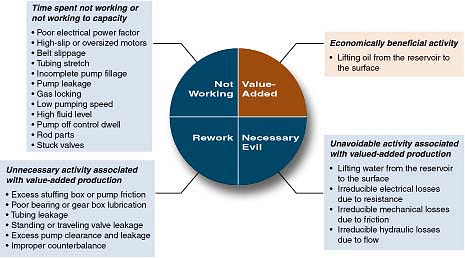
|
Improving well effectiveness by minimizing waste. |
||
|
Quickly get DynaCards and vital well data using free well reporting software. |
||
|
Analyze sucker-rod pump energy usage with our on-line calculator. |
||
|
Watch for these topics in upcoming issues. |
||
| Printer-Friendly Version | |
| Send to a Friend | |
| · Subscribe | |
| · Unsubscribe | |
![]()
| · Issue 9 | · Issue 4 |
| · Issue 8 | · Issue 3 |
| · Issue 7 | · Issue 2 |
| · Issue 6 | · Issue 1 |
| · Issue 5 |
![]()
Oil & Gas Automation
Solutions is a publication
of Unico, Inc.
Unico, Inc.
3725 Nicholson Rd.
P. O. Box 0505
Franksville, WI
53126-0505
262.886.5678
262.504.7396 fax
oilgas@unicous.com
unicous.com
Copyright © 2003
Unico, Inc.
All rights reserved.
All trade designations
are provided without
reference to the rights of
their respective owners.
|
| System Parameters |
Value
|
Power Parameters |
Value
|
|
| Pump Type |
Mark II
|
System Energy Efficiency |
44.3%
|
|
| Pump Speed |
9.3 spm
|
Motor Input Power |
38.90 hp
|
|
| Rod Stroke |
149.4 in
|
Pump Output Power |
17.25 hp
|
|
| Rod String Diameter |
0.875 in
|
Motor Power Loss |
7.30 hp
|
|
| Tubing Diameter |
2.441 in
|
Gearbox Power Loss |
2.27 hp
|
|
| Pump Diameter |
1.750 in
|
Top Friction Loss |
0.70 hp
|
|
| Pump Depth |
6375 ft
|
Bottom Friction Loss |
1.19 hp
|
|
| Fluid Depth |
6100 ft
|
Rod String Viscous Loss |
8.97 hp
|
|
| Fluid Density |
0.420 psi/ft
|
Pump Leakage Loss |
1.06 hp
|
|
| Stuffing Box Friction |
100 lb
|
Tubing Flow Loss |
0.09 hp
|
|
| Pump Friction |
200 lb
|
|
||
| Motor Type |
High Slip
|
|
||
| Motor Rated Power |
60.0 hp
|
|
||
| Motor Rated Speed |
1150 rpm
|
|
Contact us for more information on ways to minimize losses and improve the effectivess of your artificial lifts.
Free Well Reporting Software Gives DynaCards in Seconds
Unico's new SRP Field DynaCard Report software makes monitoring well performance a breeze. This powerful PC-based tool takes advantage of new reporting capabilities incorporated into the latest release of Unico's SRP software for beam-pump and Rotaflex applications. The software is bundled free of charge with new SRP drives.
|
A single-page report provides pumping unit specifications, operating status, production and |
|||||||||||||
|
power usage statistics, diagnostics, loading statistics, rod data, well and fluid data, and more. Best of all are the real-time surface and downhole dynamometer graphs and the time-based plot of crank torque. Reports can easily be printed or saved, and a Spanish-language version is available at the click of a button. Thanks to the open nature of the program's development environment, the report itself is fully customizable. Users familiar with Microsoft Excel and Microsoft Visual Basic for Applications can modify its layout, incorporate their own logo, or add any data items from the drive's global dictionary. Communication is handled by the Modbus RTU OPC server provided with the program, although any standard OPC server that supports block read functions may be used. The program requires Microsoft Excel and a Unico drive with SRP software 805164 version 12 or higher. For information on acquiring the SRP Field DynaCard Report software or the latest release of the SRP drive software, please contact us. SRP Calculator™ Enhanced to Provide Energy Analysis
|
|||||||||||||
| Taking advantage of utility rate structures to reduce artificial-lift energy costs | |
| Using a torque economizer mode to improve efficiency and reduce gearbox stress | |
| Reducing power consumption and improving power factor of beam pumps | |
| Field tests of methods to eliminate rod pump gas locking and interference | |
| Detecting stick/slip oscillations that fatigue rod-string couplings and reduce energy efficiency of PCPs | |
| The effect of pump off time on average well production |
 A Novel Way of Conceptualizing the Effectiveness of Artificial Lift Systems
A Novel Way of Conceptualizing the Effectiveness of Artificial Lift Systems

 With a simple click of the mouse, users can generate, in a matter of seconds, a comprehensive report detailing valuable statistical and analytical information for a given pumping system. Wells can be monitored individually using a direct connection in the field or remotely over a radio link, which enables an entire field to be surveyed quickly and conveniently.
With a simple click of the mouse, users can generate, in a matter of seconds, a comprehensive report detailing valuable statistical and analytical information for a given pumping system. Wells can be monitored individually using a direct connection in the field or remotely over a radio link, which enables an entire field to be surveyed quickly and conveniently.